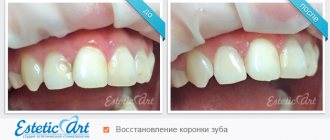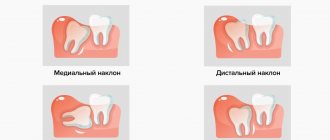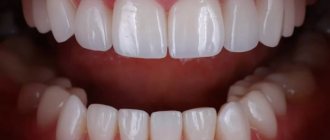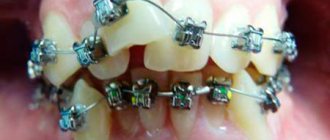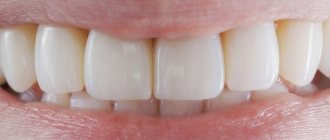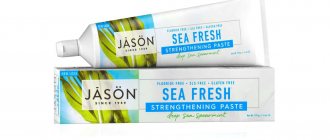To restore a number of teeth, prosthetics using crowns is used. Various materials are used for their manufacture. The main problem that can arise when using prosthetics using metal-ceramic products is the appearance of chips on the metal-ceramic crown. Is it possible to restore metal ceramics if they are chipped?
Is it possible to avoid such a situation? How is the restoration of a metal-ceramic crown carried out? Let's look at these questions in more detail.
Why does destruction occur?
Crowns can be destroyed for the following reasons:
- if the product was made of low-quality material;
- a person does not properly care for the oral cavity;
- in the presence of too heavy loads;
- if a person suffers from bruxism: teeth grinding.
How to extend the service life
After installing crowns, it is imperative to maintain oral hygiene. Brush your teeth at least 2 times a day, use floss, and purchase a toothpaste with a high degree of abrasiveness. Another mandatory requirement is to rinse your mouth after eating every time. And, of course, undergo regular inspections to ensure timely detection of damage. Thus, not only will your health be maintained, but time and money will also be saved.
In our dental clinic, doctors carefully select the material for making the crown and the design of the prosthesis. Thanks to the professionalism of the doctors, the crowns are installed in accordance with all requirements and fit tightly. It is violations of requirements and the lack of professionalism of some doctors that are a frequent reason for the destruction of the material. Therefore, you should choose only proven clinics for treatment.
Additional recommendations
The condition and life cycle of an artificial crown depends on a number of factors. First of all, we are talking about the correct installation of the prosthesis and preliminary cleaning and filling of the dental canals. Proper preparation will reduce the likelihood of developing inflammatory processes under the crown. To eliminate them, the structure will need to be removed, treated, and a new prosthesis installed.
The quality of the prosthesis is also affected by the doctor’s compliance with the technological sequence and execution of all actions. During prosthetics, the base is polished and impressions are taken correctly. The technician must obtain a model to produce the product as closely as possible to the patient's jaw.
In addition, dentures require careful handling and adherence to care recommendations:
- using a toothbrush with soft bristles;
- if there are a lot of artificial teeth in the oral cavity, it is recommended to use a paste to strengthen the gums;
- To remove plaque, it is recommended to stock up on dental floss;
- Use mouth rinses after every meal.
Another important point: people who have artificial dentures in their mouths are advised to avoid solid foods, seeds, and nuts.
Types of crowns and their properties
To prevent destruction, you should know the service life and properties of the materials from which artificial teeth are made.
In addition, not all products can be restored. If a person has structures made of plastic or metal-plastic installed, he must be prepared for the fact that they will last no more than 3 years. After this time, they may darken and break off individual pieces of plastic.
A ceramic crown is strong and reliable, but in some cases these products may also need restoration. Under the influence of strong pressure, chips may occur and cracks may appear.
Ceramic-metal products last 5-8 years. After this time, chips and cracks may appear.
The most durable are zirconium and aluminum products. Their service life is 25 years. At the same time, they do not break or become damaged, so there is no need to restore them.
If one artificial tooth is damaged, it is replaced or restored (if they are not severely damaged). For example, a small chip can be easily removed by gluing a piece of the material from which the product is made. In cases where the crown is part of a bridge or removable denture, it is better to perform a restoration than a complete replacement of the denture.
We must not forget that only a doctor can carry out the restoration procedure. Under no circumstances should you glue a broken piece of the house using household glue. This can cause serious health problems.
Materials
In dentistry, the following are used to restore a tooth crown:
- Metal plastic, fragile structures. As a rule, they are used as temporary dentures or for implantation, if artificial teeth cannot be overloaded.
- Metal ceramics (metal base with ceramic coating). The likelihood of chipping on such crowns is lower than in the previous case, but with improper care, such structures can be destroyed.
- Ceramics. Under heavy load, structures can crumble and chips occur.
- Zirconium or aluminum dioxide. When using prosthetics with these crowns, the risk of various defects appearing during wear is minimized.
Metal ceramics
Metal ceramics represent a compromise between strength, aesthetics and cost. The structures are cast from metal alloys (mainly cobalt-nickel or cobalt-chromium) and can be either individual for each unit or pavement. In some cases, the frame may be made of titanium or precious materials.
A porcelain coating is applied over the metal body to match the patient's enamel color. The mass is applied manually, layer by layer, and during the manufacturing process, each layer is fired in an oven at high temperature. This technology is necessary to create additional strength of the product.
The disadvantage of metal-ceramics (as well as metal-plastic) is the need to grind down teeth and remove nerves to install a crown.
In addition, if the decorative layer is damaged, the metal base will be visible underneath it, which is significantly different from the appearance of other teeth.
This is interesting: Cream for fixing dentures Lakalut: application features, reviews
Metal-plastic
Metal-plastic is made according to the same principle as metal-ceramics, with the difference that instead of porcelain, plastic acts as a facing material. It is cheaper than ceramics, but plastic has a number of disadvantages.
Plastic is capable of absorbing food particles during use, which can cause its surface to become stained and acquire an unpleasant odor.
In addition, the light transmittance of plastic differs from the enamel of real teeth much more than the same characteristic of porcelain, which reduces aesthetic indicators.
In addition, the problem of chipping decorative plastic coating is quite common.
Ceramics
Ceramic crowns are made from porcelain. They are created using high-temperature injection molding technology, which makes it possible to produce products of ideal shape and high strength.
Due to this technology, ceramic crowns do not require metal frames, although they are somewhat inferior in wear resistance to metal-ceramic structures.
Unlike metal-ceramics, porcelain crowns have a much more aesthetic appearance and stability.
The disadvantage of such products is the impossibility of manufacturing bridge structures (only individual dentures for the crown of teeth are made from ceramics). In addition, such products have a high cost.
Zirconium dioxide
Zirconium dioxide crowns are also ceramic-coated products. Zirconium dioxide is one of the most modern materials for the manufacture of dental crown prostheses.
The frame of zirconium crowns is very durable and has a natural color – white or close to the color of the patient’s enamel. A layer of sintered porcelain is applied on top of it.
This structure allows you to combine strength and high aesthetics. Zirconium crowns do not show through when exposed to direct color, which further increases their aesthetics.
Causes of damage
Damage to a ceramic crown can occur for the following reasons:
- the patient suffers from bruxism , and the dentist who performed the prosthetics was not informed about this diagnosis;
- a dental bridge includes a fairly large number of replaced dental units , as a result of which a fairly strong external and internal pressing force acts on it;
- during the manufacturing process of the device, the technician did not take into account the ability of the composition to thermal expansion;
- the shape of the prosthesis is made with errors , due to which uneven mechanical pressure is exerted on it, coming from the opposite area of the prosthesis, the jaw row;
- a foreign body has penetrated into the space between the surface part of the organ and the tooth , and a stony plaque has formed;
- violation of technology during the manufacturing process at the stage of firing the structure;
- patient non-compliance with the instructions for using the product;
- incorrect preparation of the problem tooth, incomplete taper - as a result, tension arises inside the system, which provokes surface chips;
- too thick fixing cement composition;
- failure to comply with the technology and temperature conditions for working with ceramic composites specified by the manufacturer.
How durable is tooth restoration with a ceramic inlay, and what factors influence the service life of products.
Come here if you are interested in a method for removing a crown from a tooth without damaging it.
At this address https://zubovv.ru/protezirovanie/nesemnyie-p/koronki-np/metallokeramicheskih-noritake.html we’ll talk about the pros and cons of Noritake metal-ceramic crowns.
Restoration methods
For different types of damage, restoration methods are provided that differ in the degree of impact on the crown. They differ in the depth of updating, reliability, and, in accordance with this, the financial expenses of the patient.
Polishing
The use of polishing is justified only in cases of minor scratches and changes in enamel color. The number of polishing applications is limited, since this procedure can thin the enamel. The procedure is carried out after professional teeth cleaning.
Application of composites
Composite materials are used to repair chips and cracks. To do this, a composition similar to the original material (i.e., the one from which the crown is made) is applied layer by layer to the problem area and illuminated with an ultraviolet lamp.
The method allows you to effectively restore the damage received, however, the risk of getting a repeat chip becomes slightly higher than before the loss of the integrity of the dental unit.
In the video, watch the technique of restoring a metal-ceramic crown after a chip.
Complete replacement
A complete replacement of a tooth is required in cases where the crack is so significant that restoration with composites will not be effective, or when the chip has affected a large area of the tooth.
In this case, a new crown is made for the patient, which is installed on the basis of an existing, damaged one. This method is effective, but requires significant financial costs.
Restoration technique after removal
Repairing metal-ceramic structures is complex and requires strict adherence to technology. In order not to destroy the crown during removal, and to safely fix it in place after restoration, it is necessary to use special tools.
For example, the Coronaflex device allows you to remove the structure using compressed air. In this case, the crown is not damaged at all, but such a procedure requires large financial costs.
The method of de-cementing a structure using ultrasonic exposure also helps preserve the integrity of the product. But some materials are not susceptible to this effect (for example, glass ionomer cement).
The doctor can use special instruments with which he controls the force of the load on the tissue and the product:
- device with a hook-shaped tip;
- special forceps;
- separating bolt;
- pneumatic hand tools;
- crown removers manual or automatic.
As a rule, the structure is removed under local anesthesia, so the patient does not feel any discomfort.
This is interesting: Is it necessary to remove dentures at night: types of dentures, material, rules of use and storage, oral hygiene and dental advice
After removal, the dentist gives the product to the dental technician in the laboratory. The restoration procedure for minor damage takes approximately 2-3 hours.
The specialist restores the original appearance of the product by gluing the missing piece using a special composition.
If a fragment is lost, a layer of ceramic is applied to the damaged area, after which the product is dried in a special oven, then sharpened and polished using special equipment.
This method is not very effective and there is a risk of damage to the crown during removal. In addition, it is possible that the structure will break again.
Tooth restoration with a crown
Dental restoration using crowns is the most common method of dental restoration. Dental crowns are used to restore the appearance and function of teeth that have defects, are destroyed by caries or as a result of injury. Previously, stamped crowns made of precious or medical alloys were common, but now preference is given to modern materials that look more natural and natural.
The most popular crowns are metal-ceramic , consisting of two layers - a metal frame and a ceramic outer layer. Metal-ceramic crowns are strong enough, which is ensured by a metal frame, and the ceramic layer applied to it gives the crown an aesthetic appearance. Such crowns can be used to restore both lateral and front teeth. Depending on the situation, such crowns can be made so that the ceramic covers only certain parts of the teeth, and the rest of the crown can be made of metal. The metal used is cabaltochrome alloys, titanium, alloys with gold, silver or palladium, which do not oxidize. Modern technologies make it possible to very accurately convey all possible shades of teeth without a bluish metallic tint.
The disadvantages of this type of crown include the fact that the metal frame under the ceramic surface can sometimes appear as a dark line at the edge of the crown, which is not very aesthetically pleasing. In addition, metal-ceramic crowns, due to their strength, contribute to severe wear of opposing teeth.
Also very aesthetically pleasing are all-ceramic crowns made from porcelain or other ceramic material, which make it possible to give the crown the color of a real tooth and look natural and aesthetically pleasing. Ceramics does not oxidize, does not wear off, and does not have a negative effect on the oral cavity, however, such crowns are inferior to others in strength, so they are most often placed on the front teeth. In addition, all-ceramic crowns are very expensive.
Ceramic crowns on a translucent zirconium oxide are the most gentle on tooth tissue compared to other crowns. Such crowns are made in two stages. First, the crown frame is made from zirconium oxide, and then the crown frame is covered with ceramic mass. Zirconium oxide crowns are very durable and do not change color for a long time.
The crown itself is placed on the tooth restored with a filling with a pin or stump.
The stump inlay is made of the same material as the frame for the crown and is a structure that extends into the dental canals and recreates the stump of the tooth on which the crown is placed.
The stump tab takes on part of the chewing pressure and helps distribute it evenly over the entire root. For example, if you want to restore a tooth using a crown on a zirconium frame, then the tooth stump should be made of a filling on fiberglass pins or a zirconium inlay. In case of severe tooth decay, the crown and inlay for its restoration should be made of biocompatible materials, for example, zirconium oxide. Restoring a tooth with a crown occurs in stages: partial unfilling of the dental canals and taking a plaster cast under the inlay, after which you are given a temporary filling. The image is taken not only from the tooth being restored, but also from the opposite jaw, which will help the technician take into account the characteristics of the bite when making the inlay. In the laboratory, a metal inlay is cast from an impression or laser-cut from zirconium.
After which, the dentist cements the inlay into the roots of the tooth and grinds it and part of his own teeth into a crown. This is a very difficult job, because... you need to create a thin, uniform ledge approximately 0.5-2 mm thick so that the crown fits perfectly. After that, impressions for the crown are taken from both jaws, and the patient is given a temporary crown. A temporary crown or plastic prosthesis protects the tooth from various irritants and also creates the appearance of the presence of the tooth. In the laboratory, the crown frame is turned or cast, and then the ceramics are laid out by hand and baked in a special oven. Then the doctor uses cement to fix the crown on the tooth. The cement is evenly distributed inside the crown, after which it is placed on the tooth. It is very important that the crown fits exactly against the tooth. The entire procedure usually lasts about 2 weeks.
This is interesting: Skyces - dental decoration: pros and cons, proper care
The main advantage of crowns is that tooth tissue is better preserved, because Usually the crown sits tightly and hermetically, so neither microbes nor saliva get under the crown, so caries does not develop. Metal-ceramic crowns are very durable and do not change color over time. However, crowns are quite rigid structures, which is not good for opposing teeth. In addition, the gums, due to the fact that the crown is a foreign object, may begin to move away. To avoid this, crowns are placed on the ledge of the tooth, and not deep in the gum, and crowns with an edge made of biocompatible materials or with a solid ceramic edge are also recommended.
Ceramic crowns are considered the most aesthetic crowns that are placed on the front teeth, and crowns on a zirconium oxide frame are considered the most durable, so they are placed on the lateral (chewing) teeth. The crown should follow all the depressions and tubercles of the tooth, and sit like a natural extension of the tooth - without jagged edges, and it should not get in the way. If you feel any discomfort, contact your healthcare provider who can resurface the crown.
Repair with pins
If the bone tissue is destroyed by caries or mechanical trauma, but the root remains healthy, restoration is performed with pins. This is a thin rod that is inserted into the canal and fixed directly to the root area. The structures are strong and reliable frames.
The pin can be metal or fiberglass. The metal, or anchor pin, can be titanium or made from an alloy of gold and palladium. The area of fixation is the root canal. The material for fastening is thread and cement. The anchor pins are visible through the dental tissue. For this reason, when restoring the front teeth, a transparent but strong fiberglass pin is used.
Restoration with tabs
Inlays, unlike fillings, are made in a laboratory, so they are much stronger than a filling. After the installation process, secondary caries does not develop, and this is one of the advantages of this restoration method. Another positive aspect is the fact that the polished inlay is completely invisible on the tooth.
Price
On average, the cost of restoring a chip on a metal-ceramic crown ranges from 2,500 to 4,500 rubles. Restoration using composite materials will cost approximately 3,000 rubles, and using solid inlays - from 4,000 rubles.
Re-polishing the restoration costs approximately 400 rubles, and making a new crown costs more than 10,000 rubles.
First of all, the price depends on the size and location of the damage. The qualifications of a specialist are of great importance. If the chip occurred as a result of an error by the dentist or dental technician, the patient does not pay for the repair.
The video presents a master class on intraoral repair of a prosthesis when the ceramic veneer is chipped.
Metal-ceramic crowns
Cracks and chips of a metal-ceramic crown in most cases occur if combined materials were used to make the structure. There may be the following chipping options:
· If the product consists of a metal frame and plastic cladding, then chips and breakages are not a rare occurrence. This is because plastic does not bond well with other materials. In this situation, it is necessary that the structure be only temporary.
· If the product is a combination of metal and ceramics, chips are formed much less frequently, since ceramic failure can only occur under extremely high loads or due to mechanical damage.
Reviews
Most often, crowns are damaged after injury or due to improper dental care. Experts believe that it is necessary to restore chips as early as possible in order to avoid complete destruction of the product.
If you want to ask any questions about restoring the integrity of the crown or simply share your feedback, write them in the comments to this article.
Sources:
- https://www.adent.ru/vosstanovlenie-koronki-zuba
- https://pcvoice.ru/lechenie/restavraciya-koronok-zubah
- https://zubovv.ru/protezirovanie/nesemnyie-p/koronki-np/sposobyi-vosstanovleniya.html
- https://anZub.ru/protezirovanie/vosstanovlenie-koronkovojj-chasti-zuba/
- https://www.vash-dentist.ru/protezirovanie/nesemnyie-p/koronki-np/skol-keramiki-kak-ustranit-defekt.html
- https://medside.ru/shtiftyi-i-koronki
- https://www.tssdent.ru/vosstanovlenie-restavraciya-koronki/
Forecast
Regardless of which of the listed methods the restoration was carried out, it is very difficult to name a specific service life.
This is determined by the following factors:
- the magnitude of the damage - with sufficiently large chips, the risk that the new prosthesis will collapse quickly is much greater than with minor damage;
- the base of the product - if made of metal, the adhesion force with the composite is lower than with ceramics;
- bite pathology – a defect can provoke new damage immediately after repair;
- oral care
- bridge system is too long;
- insufficient tightness of the adhesion during the restoration process - over time, it loses its ability to set even more, and the fragment will break off again.
